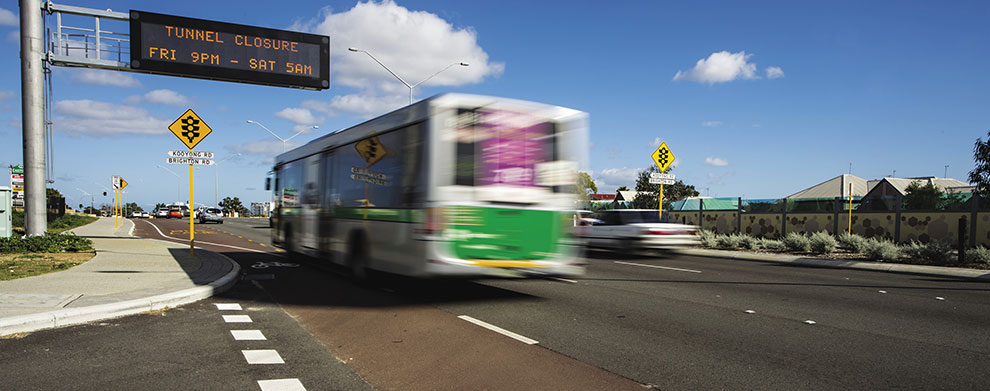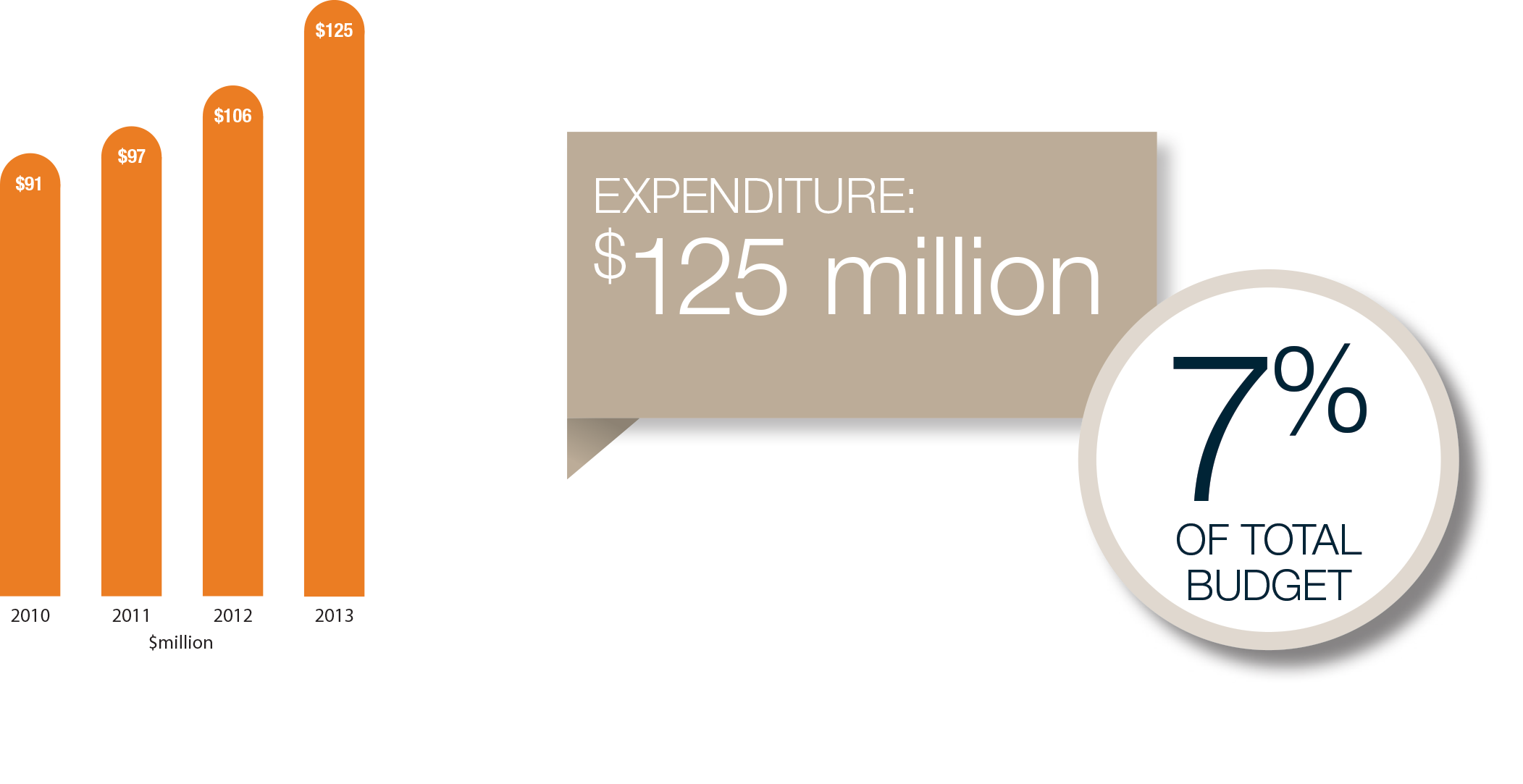
Road Management
Providing Reliable and Efficient Movement of People and Goods
This program optimises real-time management of the network, provides traveller information, improves asset management planning, and supports service delivery.

Key Performance Indicators
2013 Target |
2013 Actual |
Result |
|||
% of contracts completed on time |
90% |
86% |
✔ |
||
% of contracts completed on budget |
90% |
100% |
✔ |
||
% Network configuration |
Roads |
90% |
89% |
✔ |
|
Bridges |
Strength |
87% |
88% |
||
Note: Road Efficiency and Road Management both contribute to the outcome of ‘providing reliable and efficient movement of people and goods’ and so share some key indicators.
Introduction
The Road Management Program covers activities associated with the management and operations of the road network including providing technical advice about the road network that cannot be allocated to a specific road project. It includes achievements of the State’s Traffic Operations Centre, Road Safety Support, Heavy Vehicle Operations, and Planning and Technical Services. Some of the key projects and research activities delivered through the program are outlined below.
Traffic Operations Achievements
We have continued to roll-out Intelligent Transport Systems (ITS) aimed at providing new opportunities to manage congestion and reduce road crashes and the environmental impacts of transport. Some of the foundation infrastructure delivered through the Efficiency Program as well as other initiatives implemented over the past year include:
- Fifty CCTV cameras installed to assist with Incident Response Management.
- Roe Highway ITS expansion: 16 kilometres of fibre optic cable added.
- Reid Highway ITS expansion: 16 kilometres of fibre optic cable added.
- Five Variable Message Signs installed on Great Eastern Highway and Roe Highway.
Road Safety Support Achievements
All details of our Road Safety policy and guidelines, along with a range of safety tools and information that may be of use to practitioners and the community, are available on our website.
Fatal Crash Investigations
A total of 147 preliminary fatal crash investigations were undertaken over the past year. In addition, 58 comprehensive full reports have been completed. Improvements identified during the assessments are collated into a Corrective Action Report and sent Asset Managers for action.
Traffic Management Code of Practice
The Main Roads Traffic Management for Works on Roads Code of Practice was updated and released in June 2013. This release of the Code contains substantial roadwork traffic management improvement initiatives.
We have developed a Provision of Service Agreement for the delivery of accreditation by Registered Training Organisations (RTOs). The service agreement provides a framework that enables us to select, register and monitor the performance of RTOs. This agreement will improve the standard of traffic management throughout the State.

Heavy Vehicle Operations Achievements
Vehicles over 19 metres long, 4.3 metres high, 2.5 metres wide or over 42.5 tonne gross mass are classed as Restricted Access Vehicles (RAVs). Heavy Vehicle Operations (HVO) regulates access to WA’s road network for RAVs via a system of notices and permits. With a strong focus on innovation and cutting red tape, we are increasingly at the forefront of developing and implementing measures aimed at improving efficiency, road safety, community amenity and the preservation of road infrastructure.
The following are some of the initiatives we have undertaken over the last 12 months:
Over-Size, Over-Mass Unit
In April 2012, Transport Minister Troy Buswell announced the introduction of a ‘one stop shop’ to provide the heavy vehicle industry with a centralised point of contact to process permit applications and approvals required to conduct over-size, over-mass movements.
The Unit is facilitating approvals with a steadily increasing volume of Over-Size, Over-Mass (OSOM) movements more efficiently and effectively, providing industry with the confidence to commit to planned ventures, providing jobs, and supporting the growth of the Western Australian economy.
One particularly innovative feature is the Unit’s cost-recovery business model that provides operators with fiscal certainty and the ability to budget effectively, as well as relieving taxpayers of the requirement to underwrite services provided to commercial industry.
Officially launched on 1 January 2013, the OSOM Unit has provided the following immediate and far-reaching benefits:
- Transport operators no longer have to deal with up to four separate agencies to conduct OSOM movements.
- A core team of traffic escort wardens has been established, allowing police officers to return to front line duties.
- A Heavy Vehicle Helpdesk (138 HVO) has been established providing a single point of contact, extended hours of service and first point issue resolution. In its first six months, it received 27,204 calls.
- Since March 2012, following a successful trial in the Pilbara region, night movements of OSOM loads have been allowed in the Perth Metropolitan area, reducing traffic congestion for daytime road users. The Pilbara trial saw over 130 convoys, consisting of up to seven over-size loads between 8.5 metres and 15 metres wide, complete moves from Port Hedland to the Solomon and Jimblebar mine sites.
- Overhead power lines have been relocated underground at eight key locations on the Great Northern Highway and a further seven on the Melville to Mandurah corridor. A program has been put in place to underground more power lines on key high-wide load corridors.
- Five extra pullover and layover bays on the Great Northern Highway between Port Hedland and Newman were provided. Pullover bays are temporary parking spaces for OSOM loads to allow backed-up traffic to overtake, while layover bays allow single loads and convoys to park off-road if required.
On-line Permitting System
Phase One of MOVES, our new online permitting system, was launched in April 2013. The system is a significant cost-cutting initiative and a means of reducing time-consuming administration. MOVES Phase One enabled registered users to seamlessly apply for, pay and obtain Class One RAV Oversize Period Permits and the Class One RAV Oversize Boat Trailer Period Permits; make payments for permits and accreditation; and access a range of user-updated payment, contact and fleet information. Phase Two, released in June 2013, enabled registered users to apply online for complex permits such as Single Trip Combination Permits, Single Trip Oversize Permits and Single Trip Extra Mass Permits; request traffic escort bookings; and add and update vehicle details online rather than submitting a written form.
Accreditation
We assumed responsibility for the accreditation of pilots with the implementation of the OSOM Unit. Pilots provide warnings of an oversize load, direct other road users, and ensure safe passage of the load. Current regulatory arrangements are being reviewed and an improved system to regulate pilots is being developed. The new system will aim to improve the professionalism of pilots across the industry and will provide an effective mechanism to ensure that standards of operation are adhered to. We will take responsibility from training providers for the issuing of pilot accreditation cards in late 2013, with the complete roll out of new operating arrangements in early 2014.
Permits
A significant reduction in red tape came with the consolidation of Prime Mover/Trailer Combination and Truck/Trailer Combination Period Permits – the two most commonly issued permits for restricted access vehicles – into a single Gazette Notice. The consolidation removed the $50 permit fee as well as removing the application, renewal and issuing processes, saving industry an estimated $250,000 a year and bringing us into line with other States.
Compliance
We are responsible for monitoring and improving heavy vehicle compliance outcomes of road safety and infrastructure protection, minimising the impact of road transport on the community, and reducing unfair competitive advantage through non-compliance. The Compliance and Enforcement Legislation (Chain of Responsibility), due to be implemented in 2014, will extend responsibility for the safe movement of freight by road to everyone involved in the transport process. We will run a major communications campaign to provide stakeholders with a comprehensive overview of their responsibilities under the new reforms.
Industry Reform
We participate in various national reform initiatives which will play a major role in shaping the transport industry of the future, including:
- The National Heavy Vehicle Regulator (NHVR) commenced limited services in January 2013. During 2013, all States and Territories (except WA) are expected to pass enabling legislation that applies the Heavy Vehicle National Law in their jurisdiction. Our Government is committed to ensuring that the State’s interests are protected and a thorough evaluation of the potential impacts on the State’s finances, economy and transport will be conducted before it commits to this major reform. We are participating in the NHVR Project at all levels to ensure the State’s position is understood.
- Heavy Vehicle Charging and Investment is a Council of Australian Governments’ reform to improve the link between road use and investment by considering alternatives to the current fuel registration-based heavy vehicle charging regime.
- Performance Based Standards focuses on how well the vehicle behaves on the road, rather than how big and heavy the vehicle is. It allows industry additional opportunities to innovate, resulting in improved productivity for a given freight task, safer performance and the least possible effects on roads and bridges.
- Intelligent Access Program is a move towards self-regulation. It gives operators enhanced access to the road network in return for self-monitoring their compliance with access conditions using in-vehicle communications technology.
Accredited Mass and Loading Scheme
We are at the forefront of developing an extra mass loading scheme, replacing the existing 20-year-old framework. Recommended by the Ministerial Heavy Vehicle Advisory Panel, the new Scheme will be rolled out in two stages. Stage One comprises the amalgamation of two existing extra mass schemes and development of a new Accreditation Module. Stage Two will consolidate and include more industry-specific mass schemes, including the Livestock Concessional Loading Scheme and the Import and Export Container Scheme. Underpinning the proposed arrangements will be a new Mass Management module aligned with WA Heavy Vehicle Accreditation. Prescriptive standards for ensuring and demonstrating compliance with mass and loading requirements are included in the provisions of the new Road Traffic (Vehicles) Act 2012, to be proclaimed in 2013.
Planning and Technical Achievements
Monitoring the Bicycle Network
We play a key role in monitoring Perth cyclists and released the draft Western Australian Bicycle Network (WABN) Plan in March 2012. The development of the WABN Plan was assisted by data collected from 11 permanent cycle count sites located around the Perth CBD from 2008.
Data from these sites showed a 14% increase in cycle traffic between 2011 and 2012. Cycle count sites are now automated and operate continuously with data available within one week of collection.
The number of permanent count sites on the Perth bicycle network has doubled over the last 18 months to 24 sites, covering both recreational and commuter routes.
For more information on the WABN Plan, please visit this website.
IRIS Data Improvement Project
The Integrated Road Inventory System (IRIS) Improvement Project was initiated to review data management processes. This followed the commencement of the integrated service agreements as Regions resumed responsibility for updating and managing IRIS data.
There was a clear business need to ensure that effective data management processes were in place to undertake sound operational asset management. To drive this change into meaningful outcomes, the project focused on developing new, efficient and sustainable data management practices. The IRIS Assurance Framework is the cornerstone of the project and was developed for the ongoing monitoring and assessment of data management processes. It is encouraging to see the commitment of regions to the framework which ensures the sustainable integrity of corporate asset information.
ikeGPS
The ikeGPS is an all-in-one GPS enabled tool for field data pick up. This initiative allows the regions to streamline field capture of asset information. With the press of a button, the device uses an inbuilt laser to capture the coordinates of any object (accurate to one metre) from a distance of 300 metres. Customised menus can be deployed to the ikeGPS allowing users to control information collected for each asset type. Regions have used the ikeGPS for collecting signs, culverts, parking bays and surfacing information and have found it time saving and easy to use.

The Eelup Roundabout
With an internal diameter of 180 metres, the Eelup roundabout is the State’s largest and is located at the entrance to the City of Bunbury where it connects four major roads including the main link between Perth and the South West. At 140 crashes per year, the intersection had one of the worst crash histories in the State. During peak periods and more particularly during holiday peaks, motorists experienced considerable delays. The upgrade of the roundabout saw the delivery of Western Australia’s first ever fully signalised roundabout. This innovative traffic engineering solution was designed to address both safety and congestion issues. The outcome has surpassed expectations with current data showing a reduction in the crash rate by about 75%, and traffic flowing efficiently even at the busiest times.
Recognition
2012 WA Transport Industry Awards
- Winner ‘NTI WA Transport Woman of the Year’ – Kellie Houlahan, Project Manager Heavy Vehicle Operations
- Joint Winner ‘Freight & Logistic Council WA Most Outstanding Contribution to the WA Road Transport Industry’ – Pascal Felix, Director Heavy Vehicle Operations
2012 WA Transport & Logistics Awards
- High Commendation in the ‘Innovation Award’ category – Heavy Haulage
Looking Ahead
- Develop a process to review traffic signal operation and co-ordination.
- Deploy Network Operation Plans and operational improvements for key congested road corridors.
- Provide a new ITS Control System for the Traffic Operations Centre.
- Implement an interactive training package to ensure Road Traffic Engineering graduates are exposed to the principles of road design and drainage.
- The new Chain of Responsibility legislation is due for implementation in 2014.
Case Study
Easing Congestion: Active Traffic Management
The $105 million CBD Transport Plan includes a range of transport solutions to improve the operation of the CBD road network and address the challenge of Perth’s rapidly increasing population over the next five years. Read more...


